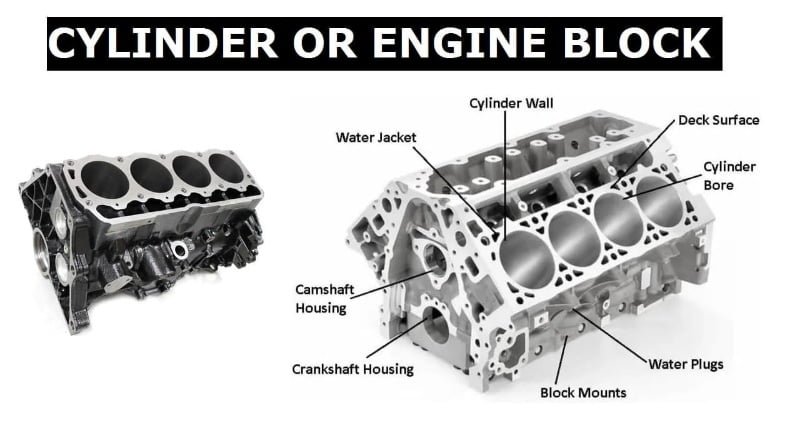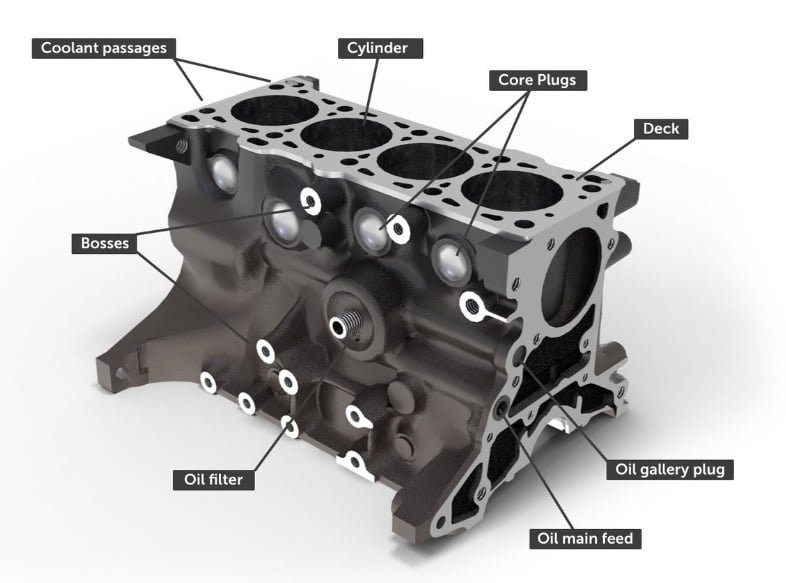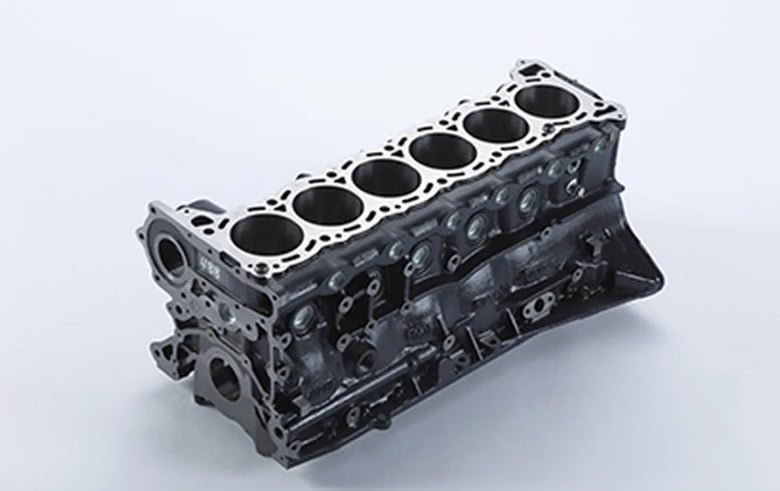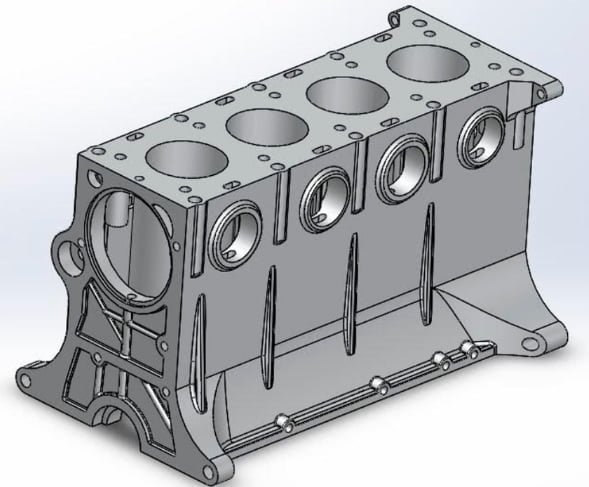what is cylinder block
Certainly! A cylinder block, also known as an engine block or block, is a critical component of an internal combustion engine. It is typically made of cast iron or aluminum and serves as the foundation for the engine’s various components, including the cylinders, pistons, crankshaft, and camshaft.
The cylinder block houses the cylinders, which are cylindrical bores where the pistons move up and down. The number of cylinders in an engine can vary, with common configurations being four, six, or eight cylinders. Each cylinder contains a piston that moves within it, and together they create the combustion chamber where air and fuel mix, ignite, and produce power.

In addition to the cylinders, the cylinder block also includes various passages and channels for coolant flow to maintain proper engine temperature and oil passages to lubricate moving parts. It also provides mounting points for other components such as the cylinder head, which houses the valves and often the camshaft.
Overall, the cylinder block is a crucial part of an engine, as it provides structural support and houses many vital components necessary for the engine’s operation. It plays a significant role in the engine’s performance and durability.
structure of cylinder block
The structure of a cylinder block, also known as an engine block, is a complex and essential component in an internal combustion engine. It consists of various elements and features that are designed to support the engine’s operation. Here’s an overview of the structure of a typical cylinder block:
Certainly! Here’s a more detailed description of each structure and component of a cylinder block in an engine, with an increased number of words for each:
- Cylinder Bore:
The cylinder bore is a precisely machined cylindrical cavity within the engine block where the piston reciprocates during the four-stroke combustion process. Its diameter and finish are critical for ensuring efficient piston movement and proper sealing with the piston rings. Multiple cylinder bores are incorporated into the engine block, with their arrangement dictated by the engine’s configuration, such as inline, V-shaped, flat-four, or other layouts. - Crankcase:
The crankcase forms the lower section of the engine block and serves as the housing for the crankshaft. It also accommodates the connecting rods that link the pistons to the crankshaft. Inside the crankcase, main bearings are strategically positioned to support the crankshaft’s rotation, ensuring smooth and precise engine operation. The crankcase plays a pivotal role in maintaining engine rigidity and protecting the internal components from contamination. - Cylinder Head Deck:
The cylinder head deck is the uppermost surface of the cylinder block, meticulously machined to provide a secure mounting platform for the cylinder head. The cylinder head houses essential components such as valves and combustion chambers. The precision of this surface is paramount, as it dictates the compression ratio and affects the overall engine performance. Proper sealing between the cylinder head and block is achieved through this machined deck. - Coolant Passages:
Integrated within the cylinder block are passages or galleries designed to facilitate the circulation of engine coolant. These passages allow for the efficient transfer of heat away from the combustion chambers and other high-temperature areas within the engine. The coolant passages are interconnected with the radiator and other cooling system components, ensuring that the engine maintains its operating temperature within optimal limits. - Oil Passages:
In addition to coolant passages, the engine block contains a network of oil galleries. These galleries are responsible for the distribution of engine oil to various critical components, including bearings, pistons, and camshafts. Proper lubrication within these galleries is essential to minimize friction, reduce wear, and extend the engine’s lifespan. - Main Bearing Caps:
The main bearing caps are precision-engineered components securely fastened to the underside of the engine block. Their primary function is to firmly hold and align the crankshaft, providing stability and support for its rotational forces. These caps are crucial for maintaining the crankshaft’s position and preventing undesirable vibrations within the engine. - Camshaft Bearings:
Some engine blocks include provisions for mounting the camshaft. Camshaft bearings, located within these provisions, allow the camshaft to rotate smoothly. The camshaft controls valve timing and, consequently, the engine’s performance. Proper bearing surfaces are vital to ensure precise and reliable valve actuation. - Accessory Mounting Points:
The engine block features strategically positioned threaded holes and mounting surfaces that facilitate the attachment of various accessories and ancillary components. These include the alternator, power steering pump, air conditioning compressor, engine mounts, and more. These mounting points contribute to the versatility and adaptability of the engine for different applications. - Freeze Plugs:
Freeze plugs, also known as expansion plugs or core plugs, are thoughtfully placed within the engine block. They serve multiple purposes, including providing access for cleaning and maintenance of the engine’s interior. Additionally, in extremely cold temperatures, they prevent the block from cracking by allowing for the expansion of freezing coolant. - Reinforcements and Reinforcing Ribbing:
To enhance structural integrity and strength, the engine block incorporates reinforcing ribbing and additional material in critical areas, particularly around the cylinder bores and main bearing zones. These reinforcements contribute to the block’s durability, resistance to stress, and overall longevity. - Exhaust Ports:
In select engine designs, the cylinder block may feature exhaust ports or passages. These specialized pathways direct hot exhaust gases from the combustion chambers to the exhaust manifold, facilitating the expulsion of spent gases from the engine. - Alignment and Machining Marks:
Precision machining marks and alignment features are meticulously integrated into the cylinder block. These marks ensure the accurate assembly of critical components, such as pistons, crankshafts, and cylinder heads, promoting precise fitment and optimal engine performance.

The intricate design and arrangement of these structural elements are tailored to the engine’s specific configuration and intended use. Nonetheless, every cylinder block shares the fundamental purpose of housing essential engine components, enabling efficient coolant and oil circulation, and guaranteeing the engine’s overall robustness and performance.
Materials used for Cylinder or Engine Block
Cylinder blocks, also known as engine blocks, are typically made from specific materials chosen for their durability, thermal conductivity, and weight characteristics. The choice of material can vary depending on the engine’s purpose, cost considerations, and performance requirements. The two primary materials used for cylinder or engine blocks are:
- Cast Iron: Cast iron has been a traditional and widely used material for engine blocks for many years due to its excellent strength and durability. There are several types of cast iron used in engine blocks:
- Gray Cast Iron: Gray cast iron is the most common type used for engine blocks. It has good castability and is known for its ability to dampen vibrations, making it ideal for many passenger car engines.
- Ductile Cast Iron (Nodular Cast Iron): Ductile cast iron offers increased strength and ductility compared to gray cast iron. It is often used in engines that require higher performance and durability, such as some diesel engines.
- Compacted Graphite Iron (CGI): CGI is an advanced form of cast iron that offers superior strength and thermal resistance. It is used in high-performance and heavy-duty applications, especially in modern diesel engines.
- Aluminum Alloy: Aluminum alloy engine blocks are known for their lightweight properties, which can contribute to improved fuel efficiency and vehicle performance. Aluminum alloys used in engine blocks include:
- Aluminum-Silicon Alloys: These alloys are commonly used in lightweight engine blocks. They offer good thermal conductivity and are often used in passenger car engines.
- Aluminum-Magnesium Alloys: These alloys provide enhanced strength and are used in some high-performance and racing engines.
- Aluminum-Lithium Alloys: Some advanced engines, particularly in aerospace applications, use aluminum-lithium alloys to further reduce weight while maintaining strength.
Aluminum engine blocks are favored in many modern vehicles to reduce overall vehicle weight and improve fuel economy. However, they often require additional engineering solutions to address concerns about thermal expansion and wear resistance, such as the use of cast-in iron cylinder liners or special surface treatments.
The choice between cast iron and aluminum depends on various factors, including the intended application, cost constraints, desired engine performance, and the automaker’s engineering priorities. Additionally, some engines may use a combination of materials, such as an aluminum block with cast iron cylinder liners, to achieve a balance between weight and durability.
Types of Cylinder or Engine Block
There are several types of cylinder or engine blocks, each designed for specific applications and engine configurations. Here are some common types:
- Inline Cylinder Block: An inline engine block is characterized by all its cylinders positioned in a single row along a common axis. This simple and efficient design is often found in four-cylinder and six-cylinder engines. Due to its compact nature and ease of manufacturing, inline engines are commonly used in a wide range of vehicles, from small economy cars to mid-sized sedans and even some light trucks. Their straightforward layout makes them relatively cost-effective to produce and maintain, and they are known for their balanced power delivery and fuel efficiency.
- V-Shaped Cylinder Block: V-shaped engine blocks, commonly referred to as V6 or V8 engines, feature two rows of cylinders arranged in a V shape. This configuration strikes a balance between power and space efficiency. V6 engines are frequently utilized in mid-sized vehicles, offering a blend of performance and fuel economy. On the other hand, V8 engines are celebrated for their robust power output and are often the engine of choice for sports cars, muscle cars, and larger vehicles like trucks and SUVs. The V-shaped layout enables efficient packaging, making it versatile for a wide array of applications.
- Flat or Boxer Cylinder Block: The flat or boxer engine block showcases a horizontally opposed cylinder arrangement with two rows of cylinders facing each other. This unique design results in a lower center of gravity and improved vehicle stability, which is particularly advantageous for sports cars. Subaru is well-known for its use of boxer engines, as this layout enhances traction and handling in its all-wheel-drive vehicles. The horizontally opposed design also reduces vibrations and contributes to a smoother ride.
- W-Shaped Cylinder Block: W-shaped engine blocks, while relatively rare, are reserved for elite high-performance and supercar engines. They feature multiple rows of cylinders arranged in a W shape, allowing for a high cylinder count within a confined space. This design enables manufacturers to achieve extraordinary power and performance levels. W-shaped engines are often seen in limited-production vehicles and represent the pinnacle of automotive engineering.
- Radial Cylinder Block: Radial engine blocks are characterized by cylinders arranged in a circular pattern around a central crankshaft. While no longer common in automotive applications, they have a storied history in aviation, where their airflow characteristics and power-to-weight ratios made them suitable for early aircraft engines. These engines offered excellent cooling and were favored for their reliability in challenging conditions. Today, they are mostly reserved for historical or niche purposes.
- Siamese Cylinder Block: Siamese engine blocks are designed with adjacent cylinders sharing a common wall. This unique construction enhances block strength and rigidity, making it particularly desirable for high-performance and racing engines. The Siamese arrangement permits larger cylinder bore sizes, accommodating increased displacement and power output. This design is a testament to the precision and durability required for extreme conditions in motorsports.
- Aluminum Cylinder Block: Aluminum engine blocks are prized for their lightweight properties, contributing to improved fuel efficiency and vehicle handling. These blocks are commonly used in modern engines, especially those in passenger cars, as they help reduce overall vehicle weight and enhance heat dissipation. The weight savings translate to improved acceleration and better fuel economy. Aluminum blocks are also more corrosion-resistant than iron, further increasing their appeal.
- Iron Cylinder Block: Iron engine blocks are celebrated for their durability, heat resistance, and strength. They remain the preferred choice for high-performance and heavy-duty applications, such as trucks, certain sports cars, and engines designed for towing or hauling heavy loads. Iron blocks can withstand high levels of stress and heat without compromising structural integrity. Their longevity and ability to handle extreme conditions make them a staple in demanding environments.
- Intercooled Cylinder Block: High-performance and turbocharged engines often incorporate intercooled blocks, featuring an integrated intercooler within the block’s design. This intercooler plays a critical role in optimizing engine performance by cooling the compressed air before it enters the cylinders. Cooler air is denser, resulting in increased power output and reduced risk of detonation or knocking. Intercooled blocks are prevalent in sports cars and performance-oriented vehicles where maximizing engine efficiency is a priority.
- Hybrid and Composite Blocks: Some advanced engines adopt innovative hybrid or composite materials in their cylinder block construction. These materials blend the benefits of various substances, such as aluminum and reinforced plastics, to achieve a balance between weight reduction, strength, and fuel efficiency. Hybrid and composite blocks are often employed in cutting-edge, eco-friendly vehicles where minimizing weight is a top priority. These blocks showcase the latest advancements in materials science and engineering, contributing to more sustainable and efficient transportation solutions.

Each type of cylinder or engine block possesses distinct advantages and characteristics, allowing engineers to tailor their designs to meet specific performance, efficiency, and durability targets. The choice of block type plays a pivotal role in determining an engine’s suitability for its intended application, from everyday commuter vehicles to high-performance sports cars and heavy-duty trucks.
Functions of Engine Block
The engine block, also known as the cylinder block, serves several crucial functions in an internal combustion engine:
- Cylinder Housing: The primary function of the engine block is to provide a housing for the engine’s cylinders. It contains the cylinder bores where the pistons move up and down during the engine’s combustion cycle. The number and arrangement of cylinders depend on the engine’s configuration (e.g., inline, V-shaped, flat).
- Support for Moving Parts: The engine block supports and encases various moving components, including the pistons, connecting rods, and crankshaft. It ensures these components are properly aligned and stabilized during engine operation.
- Coolant Passages: The block contains passages and galleries for the circulation of engine coolant. Coolant flows around the cylinder bores, helping to regulate the engine’s operating temperature and prevent overheating.
- Oil Lubrication: The engine block features oil passages that distribute engine oil to critical engine components, such as the crankshaft, camshaft, and connecting rod bearings. Lubrication is essential to reduce friction and wear between moving parts.
- Main Bearing Caps: The lower section of the engine block typically includes main bearing caps. These caps are fastened to the block and provide support for the crankshaft. They help maintain the alignment and stability of the crankshaft, which is essential for smooth engine operation.
- Crankcase: The lower portion of the engine block, known as the crankcase, encloses the crankshaft and the lower parts of the connecting rods. It also serves as the oil pan or sump, collecting and storing engine oil.
- Attachment for Cylinder Head: The top of the engine block has deck surfaces where the cylinder head attaches. These surfaces must be precisely machined to ensure a proper seal when the cylinder head is bolted in place. The head gasket seals the joint between the cylinder head and the block.
- Mounting Points: The engine block includes threaded inserts and mounting points for various engine components, such as spark plugs, engine accessories (e.g., alternator, power steering pump), motor mounts, and brackets.
- Vibration Damping: To reduce vibrations and enhance engine durability, the engine block may have reinforcing ribs, webbing, and bulkheads strategically incorporated into its design.
- External Attachments: The exterior of the engine block may feature provisions for attaching external components, including exhaust manifolds, intake manifolds, and accessories like the water pump and fuel pump.
- Coolant and Oil Ports: The engine block may have ports and openings for the installation of sensors, temperature senders, and other engine management components.
In summary, the engine block plays a central role in an internal combustion engine’s construction, housing critical components, facilitating the circulation of coolant and oil, and providing structural integrity to the engine assembly. It is a fundamental component that directly influences an engine’s performance and durability.
Common problems in the Engine Cylinder Block
The engine cylinder block is a critical component of an internal combustion engine, and while it is designed to be durable, it can still experience various problems over time. Here are some common issues that can occur with the engine cylinder block:
- Cracks: Cracks in the engine cylinder block can emerge from a range of sources, including thermal stresses, freezing temperatures, or excessive mechanical pressure. These cracks often start small but can propagate over time, potentially leading to significant damage. Cracks in the block can result in coolant or oil leaks, as well as reduced engine performance and efficiency.
- Warpage: Overheating or insufficient engine cooling can cause the cylinder block to warp. This warpage can create uneven surfaces and misalignments, impacting the proper sealing of the cylinder head to the block. Consequently, it can lead to compression loss, increased oil consumption, and reduced engine efficiency.
- Cylinder Scoring: Cylinder scoring is a condition where the walls of the cylinders develop wear marks or grooves. This issue can result from inadequate lubrication, foreign particle contamination, or problems with piston rings. Cylinder scoring can compromise engine performance, increase friction, and contribute to oil consumption.
- Corrosion: Corrosion within the cylinder block’s coolant passages or cylinder walls can stem from a lack of proper coolant maintenance or exposure to extreme environmental conditions. Corrosion can manifest as pitting or scaling, leading to coolant leaks, suboptimal heat dissipation, and internal engine damage.
- Piston Slap: Piston slap refers to the clearance between the piston and the cylinder walls, which can become excessive. This condition often leads to a knocking noise during engine operation and can cause reduced compression, increased engine wear, and potentially contribute to engine damage.
- Cracked Cylinder Liners: In certain engine designs, such as larger diesel engines, cylinder liners are employed within the block. These liners can develop cracks or become dislodged over time, potentially causing loss of compression and coolant leaks. This issue is more common in engines subjected to heavy loads or extreme conditions.
- Threaded Insert Issues: The threaded inserts used for components like spark plugs or critical bolts can degrade over time. Threaded insert damage or stripping can complicate the proper securement of these components, affecting engine reliability and performance.
- Coolant and Oil Leaks: Gasket seals within the cylinder block, such as head gaskets or oil pan gaskets, may deteriorate with time or exposure to heat and pressure cycles. This deterioration can result in coolant or oil leaks, which, if left unaddressed, can lead to overheating, lubrication problems, and internal engine damage.
- Casting Defects: During the engine block’s manufacturing process, casting defects such as porosity, voids, or inclusions may occur. These defects can weaken the structural integrity of the block, potentially leading to cracks, leaks, or even catastrophic failures.
- Excessive Cylinder Wear: Cylinders can wear unevenly over time due to factors like insufficient lubrication, suboptimal maintenance practices, or irregular combustion. This wear can result in a loss of compression, piston ring problems, and a noticeable decline in engine performance.
- Alignment Issues: Poor machining or assembly processes can lead to misaligned cylinder bores or other critical features within the cylinder block. These misalignments can adversely affect engine performance, longevity, and combustion efficiency.
- Excessive Heat Stress: Engines subjected to frequent high-load operation or inadequate cooling can experience excessive heat stress. This stress can lead to deformation, warping, or even localized melting of the cylinder block, compromising its structural integrity and overall functionality.
- Cylinder Block Erosion: In certain cases, particularly in high-performance or forced-induction engines, erosion can occur in areas exposed to combustion gases. This erosion can lead to the thinning of critical surfaces, weakening the block’s integrity and potentially affecting engine performance and safety.
- Cylinder Block Pitting: Pitting, often related to corrosion, can manifest as small craters or dimples on the cylinder walls. Pitting can negatively impact compression and the piston’s sealing capability, resulting in reduced engine efficiency and power output.

Regular maintenance, adherence to recommended service intervals, proper cooling system care, and vigilant monitoring of engine performance are essential practices to prevent or promptly address these common problems in the engine cylinder block. Early diagnosis and timely repairs are crucial to mitigate further damage and ensure the engine’s longevity and reliability.
Advantages of V engine Block over In-line Engine Block
V engine blocks and inline (or straight) engine blocks both have their advantages and are chosen based on specific design goals and requirements. Here are some advantages of V engine blocks over inline engine blocks:
- Compact Size: V engines are inherently more compact than inline engines. The V-shaped configuration allows for a shorter overall length, making them ideal for vehicles with limited space in the engine compartment. This compactness can enhance vehicle design flexibility.
- Better Balance: V engines have a natural balance due to the arrangement of cylinders in two banks that form a V shape. This balance results in reduced vibrations and smoother engine operation compared to inline engines, which may require additional balancing mechanisms.
- Higher Horsepower Potential: V engines can achieve higher horsepower outputs for a given displacement due to their design’s ability to accommodate more cylinders in a shorter length. This makes V engines a preferred choice for high-performance and sports cars.
- Improved Weight Distribution: The V engine’s compact size and balance contribute to better weight distribution in vehicles. This balance can enhance handling and stability, particularly in rear-wheel-drive and all-wheel-drive setups.
- Easier Cooling: V engines typically have better cooling characteristics because there is more space between the cylinder banks for air and coolant circulation. This helps dissipate heat more effectively, which is crucial for high-performance engines.
- Access to Accessories: V engine blocks often provide easier access to accessories such as the alternator, power steering pump, and air conditioning compressor. This can simplify maintenance and reduce labor costs.
- Enhanced Aesthetics: V engines are favored for their aesthetic appeal, as the V-shaped layout can create a visually striking engine compartment, which is important for sports cars and luxury vehicles.
- Flexibility in Cylinder Count: V engines can be designed with various cylinder counts, including four, six, eight, and even more cylinders. This flexibility allows manufacturers to tailor engine configurations to meet specific performance and efficiency targets.
- Torsional Rigidity: V engine blocks tend to exhibit better torsional rigidity due to the shorter crankshaft, which results in reduced flexing during high-stress conditions. This can improve overall engine durability.
- Exhaust Scavenging: In some V engine designs, exhaust gases from each bank of cylinders can be better managed to improve exhaust scavenging and, consequently, engine efficiency and performance.
It’s important to note that the choice between a V engine and an inline engine depends on various factors, including the vehicle’s intended use, packaging constraints, fuel efficiency goals, and desired performance characteristics. Both configurations have their strengths, and manufacturers select the one that best aligns with their specific engineering objectives and the target market for the vehicle.
Check Out Other Important Topics
| IC Engine | Important PDFs | Boilers | Synergy Maritime Exam | Naval Arch | MEO Class 4 |
| Interview Questions | Difference Between | Types of Pumps | Auxiliary Machines | Types of Valves | Home |

